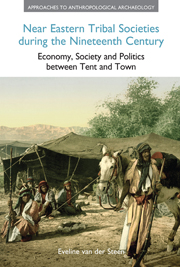 Near Eastern Tribal Societies during the Nineteenth Century
Near Eastern Tribal Societies during the Nineteenth Century Frank had taken his degree, as arranged, and had then gone abroad for the winter, doing the fashionable things, going up the Nile, crossing over to Mount Sinai, thence over the long desert to Jerusalem, and home by Damascus, Beyrout, and Constantinople, bringing back a long beard, a red cap, and a chibouk …
(Anthony Trollope, Dr. Thorne, 1858)Introduction
During the nineteenth century, first a trickle, then a stream and then an avalanche of travel books about the Near East appeared all over the Western world but particularly in Britain. Most of these covered one small part of the region: Palestine – the Holy Land. As a result of this, over the course of the century Palestine became one of the fashionable holiday destinations for the wealthy, a phenomenon that generated even more travelogues. According to Bar-Yosef (2005: 68): “The number of individuals who were willing to risk their own assets just to have their travel accounts published … suggests that it was only by joining this endless textual procession that travellers felt they had truly experienced Palestine.”
Travellers quoted, copied and plagiarized each other. Armchair scholars used these travelogues to draw up a picture of life as it must have been in the days of the Patriarchs and to “follow in the footsteps of Jesus” without ever having set foot in the Holy Land. Painters and illustrators depended on on-site sketches from travellers to paint their panoramas of the Holy Land and their impressions of daily life in the East.
To save this book to your Kindle, first ensure [email protected] is added to your Approved Personal Document E-mail List under your Personal Document Settings on the Manage Your Content and Devices page of your Amazon account. Then enter the ‘name’ part of your Kindle email address below. Find out more about saving to your Kindle.
Note you can select to save to either the @free.kindle.com or @kindle.com variations. ‘@free.kindle.com’ emails are free but can only be saved to your device when it is connected to wi-fi. ‘@kindle.com’ emails can be delivered even when you are not connected to wi-fi, but note that service fees apply.
Find out more about the Kindle Personal Document Service.
To save content items to your account, please confirm that you agree to abide by our usage policies. If this is the first time you use this feature, you will be asked to authorise Cambridge Core to connect with your account. Find out more about saving content to Dropbox.
To save content items to your account, please confirm that you agree to abide by our usage policies. If this is the first time you use this feature, you will be asked to authorise Cambridge Core to connect with your account. Find out more about saving content to Google Drive.